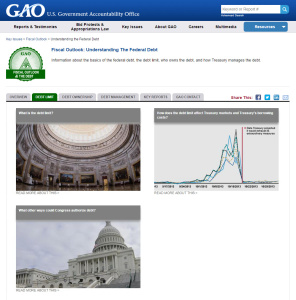GAO Insights into the Nation’s Finances and the Role of the Debt Limit
Today, U.S. Comptroller General Gene Dodaro delivered testimony to Congress on our nation’s unsustainable long-term fiscal position. He said that the Congress and administration face serious economic, security, and social challenges that will require difficult policy choices in the short term about the level of federal spending and investments, as well as ways to obtain needed resources. In addition to near-term financing decisions, a broader plan is needed to put the government on a more sustainable long-term fiscal path.
What raises these concerns? In brief, the Comptroller General highlighted the federal deficit—which increased to $587 billion in fiscal year 2016, up from $439 billion in fiscal year 2016, and the outlook for continued growth in debt as a share of our economy. He also called attention to the growing gap between revenues and spending built into current law. On the spending side of the budget, he pointed to Social Security, Medicare, Medicaid, and interest on the debt held by the public, as well as future unknown costs, such as for wars, economic, financial, or weather-related crises, known as “fiscal exposures.”
The Comptroller General also featured the importance of better managing the debt limit. While the ideas of spending and revenue may be familiar, what role does the debt limit play in the nation’s fiscal health? Today’s WatchBlog shares our latest debt limit resources to help make sense of this situation.
A brief refresher
The debt limit is a legal limit on the amount of federal debt that can be outstanding at one time. As it is currently structured, it’s an after-the-fact measure: it doesn’t prevent Congress and the President from passing future spending and revenue laws that raise or lower the debt; nor does it otherwise constrain fiscal policy. It only restricts the Treasury’s authority to borrow to finance the spending and revenue decisions that have already been made. In other words, it prevents us from paying our bills, but not from spending money.
Why the debt limit matters
From the Comptroller General’s testimony today:
I cannot overstate the importance of preserving confidence in “the full faith and credit” of the United States. Failure to increase (or suspend) the debt limit in a timely manner could have serious negative consequences for the Treasury market and increase borrowing costs.
We most recently hit the debt limit on March 15th. Since then, Treasury has been buying time by taking “extraordinary measures” to ensure that the government continues to meet its financial obligations without exceeding the limit. If these measures are exhausted before the debt limit is raised or suspended, Treasury could be forced to delay some government payments until sufficient funds become available.
To help clarify this issue, we pulled together some helpful information about the debt limit and put it in one place on our federal debt webpage. This page digs into the potential effects of operating the government at the debt limit for extended periods of time. In addition, we explore potential policy options for authorizing new debt that could minimize market disruptions while linking debt decisions to spending and revenue decisions.
You can also see implications of the debt limit in the broader context of federal debt and debt management on the Understanding the Federal Debt section on GAO.gov. There you can find out who owns the debt and read more about how the government tries to ensure that its financing needs are met at the lowest cost to taxpayers over time.
- Comments on the WatchBlog? Contact blog@gao.gov.
GAO Contacts
Related Products

GAO's mission is to provide Congress with fact-based, nonpartisan information that can help improve federal government performance and ensure accountability for the benefit of the American people. GAO launched its WatchBlog in January, 2014, as part of its continuing effort to reach its audiences—Congress and the American people—where they are currently looking for information.
The blog format allows GAO to provide a little more context about its work than it can offer on its other social media platforms. Posts will tie GAO work to current events and the news; show how GAO’s work is affecting agencies or legislation; highlight reports, testimonies, and issue areas where GAO does work; and provide information about GAO itself, among other things.
Please send any feedback on GAO's WatchBlog to blog@gao.gov.





